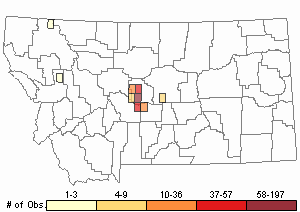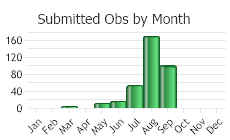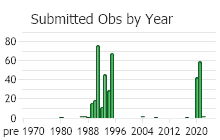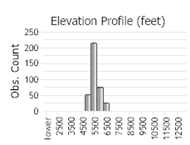View in other NatureServe Network Field Guides
NatureServe
Montana
Utah
Wyoming
Idaho
Wisconsin
British Columbia
South Carolina
Yukon
California
New York
Northern Rattlesnake-plantain - Goodyera repens
State Rank Reason (see State Rank above)
A widespread species that is found in Montana in the Little Belt and Big Snowy Mountains and at one site in Glacier National Park. The species occupies moist, montane forests with a mossy understory. Occurrences are vulnerable to disturbances that open or reduce the canopy such as timber harvesting and fire. Monitoring of the species in the Little Belt Mountains have documented negative impacts associated with both disturbances. However, Goodyera repens is known from approximately 20 moderate to large-sized populations and many additional, smaller occurrences. Recent trends are unknown.
- Details on Status Ranking and Review
Population Size
Score1 - Moderate: Generally 10,000-100,000 individuals.
Range Extent
Score1 - Peripheral, Disjunct or Sporadic Distribution in MT: Widespread species that is peripheral, disjunct or sporadically distributed within MT such that it occurs in <5% of the state (<7,500 sq. miles or the combined area of Beaverhead and Ravalli Counties) or is restricted to 4-5 sub-basins.
Area of Occupancy
Score1 - Moderate: Generally occurring in 11-25 Subwatersheds (6th Code HUC’s).
Environmental Specificity
Score1 - Moderate: Species is restricted to a specific habitat that is more widely distributed or to several restricted habitats and is typically dependent upon relatively unaltered, good-quality habitat (C Values of 5-7).
Trends
ScoreNA - Rank factor not assessed.
Threats
Score1 - Medium: 11-30% of the populations are being negatively impacted or are likely to be impacted by one or more activities or agents, which are expected to result in decreased populations and/or habitat quality and/or quantity.
CommentAny activities or events that substantially reduce the overstory and/or removes the duff/litter layer, such as thinning and logging operations or severe fires are likely to have adverse impacts.
Intrinsic Vulnerability
Score2 - High Vulnerability: Very specific biological attributes, unusual life history characteristics or limited reproductive potential makes the species highly susceptible to extirpation from stochastic events or other adverse impacts to its habitat and very slow to recover.
Raw Conservation Status Score
Score
7 total points scored out of a possible 16 (Rarity factors and threats only).
General Description
Northern Rattlesnake-plantain is an herbaceous perennial with unbranched stems that are 1-2 dm high and which arise from extensive rhizomes. The mostly basal leaves have a broad petiole that is 5-15 mm long and an elliptic blade that is 15-30 mm long. The leaves are dark green, and the stem is glandular above. Sessile flowers are borne on one side of the upper stem. The white to pale green flowers consist of a hood-like upper petal that is 3-4 mm long and of a pouched lower petal that is ca. 2 mm deep and has a sepal on each side. The corolla arises from the top of the oblong ovary. The club-shaped, many-seeded capsule is ca. 1 cm long.
Phenology
Flowering in August.
Diagnostic Characteristics
The inflorescence of G. oblongifolia is mostly greater than 6 cm long, and the leaf blades are more than 3 cm long and generally have a broad, white midvein.
Species Range
Montana Range
Range Descriptions

 Native
Native
Range Comments
Circumboreal south to AZ, NM, SD, TN and NC. Known from Flathead and Judith Basin counties (Lesica et al. 2012. Manual of Montana Vascular Plants. BRIT Press. Fort Worth, TX).
Observations in Montana Natural Heritage Program Database
Number of Observations: 724
(Click on the following maps and charts to see full sized version)
Map Help and Descriptions
Relative Density

Recency



 (Observations spanning multiple months or years are excluded from time charts)
(Observations spanning multiple months or years are excluded from time charts)
Habitat
North-facing, mossy forested slopes in the montane zone.
National Vegetation Classification System Groups Associated with this Species
Forest and Woodland
Montane - Subalpine Forest and Woodland
Stewardship Responsibility
Threats or Limiting Factors
STATE THREAT SCORE REASON
Reported threats to Montana's populations of Northern Rattlesnake-plantain include those that lead to changes in light and moisture properties of its habitat (MTNHP Threat Assessment 2021). Wood harvesting and wildfire are primary concerns because sudden exposure of the understory exceeds Northern Rattlesnake-plantain light tolerance, and is known to reduce soil surface moisture over time. Other threats including livestock trampling and grazing, recreation related trampling, road construction and maintenance, and competition from non-native plants are indicated as they have potential to inflict change on light and water properties in this habitat. Information on the scope, severity, and timing of these threats are needed to better assess relative risk to populations.
References
- Literature Cited AboveLegend:
 View Online Publication
View Online Publication Lesica, P., M.T. Lavin, and P.F. Stickney. 2012. Manual of Montana Vascular Plants. Fort Worth, TX: BRIT Press. viii + 771 p.
Lesica, P., M.T. Lavin, and P.F. Stickney. 2012. Manual of Montana Vascular Plants. Fort Worth, TX: BRIT Press. viii + 771 p. MTNHP Threat Assessment. 2021. State Threat Score Assignment and Assessment of Reported Threats from 2006 to 2021 for State-listed Vascular Plants. Botany Program, Montana Natural Heritage Program, Helena, Montana.
MTNHP Threat Assessment. 2021. State Threat Score Assignment and Assessment of Reported Threats from 2006 to 2021 for State-listed Vascular Plants. Botany Program, Montana Natural Heritage Program, Helena, Montana.
- Additional ReferencesLegend:
 View Online Publication
View Online Publication
Do you know of a citation we're missing? Achuff, P. and L.A. Schassberger. 1991. Status review of Goodyera repens, USDA Forest Service, Region 1, Lewis & Clark National Forest. Unpublished report to the Lewis & Clark National Forest. Montana Natural Heritage Program, Helena, Montana. 52 pp.
Achuff, P. and L.A. Schassberger. 1991. Status review of Goodyera repens, USDA Forest Service, Region 1, Lewis & Clark National Forest. Unpublished report to the Lewis & Clark National Forest. Montana Natural Heritage Program, Helena, Montana. 52 pp. Achuff, P.L. 1992. Status review update of Goodyera repens, Lewis & Clark National Forest. Unpublished report to the Lewis & Clark National Forest. Montana Natural Heritage Program, Helena, MT. 38 pp.
Achuff, P.L. 1992. Status review update of Goodyera repens, Lewis & Clark National Forest. Unpublished report to the Lewis & Clark National Forest. Montana Natural Heritage Program, Helena, MT. 38 pp. Alexander, C. and G. Hadley. 1984. The effect of mycorrhizal infection of Goodyera repens and its control by fungicide. New Phytologist. 97:391-400.
Alexander, C. and G. Hadley. 1984. The effect of mycorrhizal infection of Goodyera repens and its control by fungicide. New Phytologist. 97:391-400. Barclay-Estrup, P., Duralia, T.E., and A.G. Harris. 1991. Flowering sequence of the orchid genus Goodyera in Thunder Bay District, Ontario. Rhodora 93(874):141-147.
Barclay-Estrup, P., Duralia, T.E., and A.G. Harris. 1991. Flowering sequence of the orchid genus Goodyera in Thunder Bay District, Ontario. Rhodora 93(874):141-147. Catling, P. M. 1983. Autogamy in eastern Canadian Orchidaceae: a review of current knowledge and some new observations. Naturaliste Canada 110:37-53.
Catling, P. M. 1983. Autogamy in eastern Canadian Orchidaceae: a review of current knowledge and some new observations. Naturaliste Canada 110:37-53. Lesica, P., M.T. Lavin, and P.F. Stickney. 2022. Manual of Montana Vascular Plants, Second Edition. Fort Worth, TX: BRIT Press. viii + 779 p.
Lesica, P., M.T. Lavin, and P.F. Stickney. 2022. Manual of Montana Vascular Plants, Second Edition. Fort Worth, TX: BRIT Press. viii + 779 p. Phillips, H.W. 1989. Noteworthy collection - Montana (Goodyera repens). Madrono 36:174.
Phillips, H.W. 1989. Noteworthy collection - Montana (Goodyera repens). Madrono 36:174. Phillips, H.W. 1995. Conservation strategy for northern rattlesnake-plantain (Goodyera repens), Lewis & Clark National Forest. Unpublished report. Lewis & Clark National Forest. 6 pp. plus maps.
Phillips, H.W. 1995. Conservation strategy for northern rattlesnake-plantain (Goodyera repens), Lewis & Clark National Forest. Unpublished report. Lewis & Clark National Forest. 6 pp. plus maps. Sood, S.K. 1988. Development of gametophytes, embryogeny and pericarp in Goodyera repens (Orchidaceae, Neottieae). Proceedings of Indian Academy of Science (Plant Sci.) 98:149-156.
Sood, S.K. 1988. Development of gametophytes, embryogeny and pericarp in Goodyera repens (Orchidaceae, Neottieae). Proceedings of Indian Academy of Science (Plant Sci.) 98:149-156. Vij, S. P. and G. C. Gupta. 1975. Cytological investigations into W. Himilayan Orchidaceae 1. Chromosome numbers and karyotypes of taxa from Kashmir. Cytologia 40:613-621.
Vij, S. P. and G. C. Gupta. 1975. Cytological investigations into W. Himilayan Orchidaceae 1. Chromosome numbers and karyotypes of taxa from Kashmir. Cytologia 40:613-621.
- Web Search Engines for Articles on "Northern Rattlesnake-plantain"





